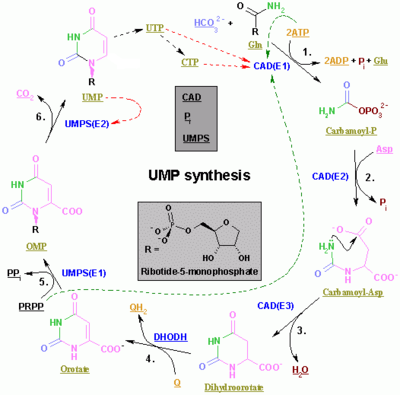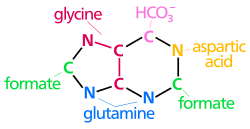Nucleotide
| Part of a series on |
| Genetics |
|---|
 |
Nucleotides are
Nucleotides are composed of three subunit molecules: a nucleobase, a five-carbon sugar (ribose or deoxyribose), and a phosphate group consisting of one to three phosphates. The four nucleobases in DNA are guanine, adenine, cytosine, and thymine; in RNA, uracil is used in place of thymine.
Nucleotides also play a central role in
In experimental
5-nucleotides are also used in
Structure
A nucleotide is composed of three distinctive chemical sub-units: a five-carbon sugar molecule, a
In
Nucleic acids then are
In addition to being building blocks for the construction of nucleic acid polymers, singular nucleotides play roles in cellular energy storage and provision, cellular signaling, as a source of phosphate groups used to modulate the activity of proteins and other signaling molecules, and as enzymatic
Synthesis
Nucleotides can be synthesized by a variety of means, both in vitro and in vivo.[citation needed]
In vitro, protecting groups may be used during laboratory production of nucleotides. A purified nucleoside is protected to create a phosphoramidite, which can then be used to obtain analogues not found in nature and/or to synthesize an oligonucleotide.[citation needed]
In vivo, nucleotides can be synthesized de novo or recycled through salvage pathways.[1] The components used in de novo nucleotide synthesis are derived from biosynthetic precursors of carbohydrate and amino acid metabolism, and from ammonia and carbon dioxide. Recently it has been also demonstrated that cellular bicarbonate metabolism can be regulated by mTORC1 signaling.[6] The liver is the major organ of de novo synthesis of all four nucleotides. De novo synthesis of pyrimidines and purines follows two different pathways. Pyrimidines are synthesized first from aspartate and carbamoyl-phosphate in the cytoplasm to the common precursor ring structure orotic acid, onto which a phosphorylated ribosyl unit is covalently linked. Purines, however, are first synthesized from the sugar template onto which the ring synthesis occurs. For reference, the syntheses of the purine and pyrimidine nucleotides are carried out by several enzymes in the cytoplasm of the cell, not within a specific organelle. Nucleotides undergo breakdown such that useful parts can be reused in synthesis reactions to create new nucleotides.[citation needed]
Pyrimidine ribonucleotide synthesis

The synthesis of the pyrimidines CTP and UTP occurs in the cytoplasm and starts with the formation of carbamoyl phosphate from
- (S)-Dihydroorotate + O2 → Orotate + H2O2
Orotate is covalently linked with a phosphorylated ribosyl unit. The covalent linkage between the ribose and pyrimidine occurs at position C1[7] of the ribose unit, which contains a pyrophosphate, and N1 of the pyrimidine ring. Orotate phosphoribosyltransferase (PRPP transferase) catalyzes the net reaction yielding orotidine monophosphate (OMP):
- Orotate + 5-Phospho-α-D-ribose 1-diphosphate (PRPP) → Orotidine 5'-phosphate + Pyrophosphate
Orotidine 5'-monophosphate is decarboxylated by orotidine-5'-phosphate decarboxylase to form uridine monophosphate (UMP). PRPP transferase catalyzes both the ribosylation and decarboxylation reactions, forming UMP from orotic acid in the presence of PRPP. It is from UMP that other pyrimidine nucleotides are derived. UMP is phosphorylated by two kinases to uridine triphosphate (UTP) via two sequential reactions with ATP. First, the diphosphate from UDP is produced, which in turn is phosphorylated to UTP. Both steps are fueled by ATP hydrolysis:
- ATP + UMP → ADP + UDP
- UDP + ATP → UTP + ADP
CTP is subsequently formed by the amination of UTP by the catalytic activity of CTP synthetase. Glutamine is the NH3 donor and the reaction is fueled by ATP hydrolysis, too:
- UTP + Glutamine + ATP + H2O → CTP + ADP + Pi
Cytidine monophosphate (CMP) is derived from cytidine triphosphate (CTP) with subsequent loss of two phosphates.[8][9]
Purine ribonucleotide synthesis
The atoms that are used to build the

 |
The atoms N1 arises from the amine group of Asp C2 and C8 originate from formate N3 and N9 are contributed by the amide group of Gln C4, C5 and N7 are derived from Gly C6 comes from HCO3− (CO2) |
The
Six enzymes take part in IMP synthesis. Three of them are multifunctional:
The pathway starts with the formation of
In the first reaction unique to purine nucleotide biosynthesis,
Next, a glycine is incorporated fueled by ATP hydrolysis, and the carboxyl group forms an amine bond to the NH2 previously introduced. A one-carbon unit from folic acid coenzyme N10-formyl-THF is then added to the amino group of the substituted glycine followed by the closure of the imidazole ring. Next, a second NH2 group is transferred from glutamine to the first carbon of the glycine unit. A carboxylation of the second carbon of the glycin unit is concomitantly added. This new carbon is modified by the addition of a third NH2 unit, this time transferred from an aspartate residue. Finally, a second one-carbon unit from formyl-THF is added to the nitrogen group and the ring is covalently closed to form the common purine precursor inosine monophosphate (IMP).
Inosine monophosphate is converted to adenosine monophosphate in two steps. First, GTP hydrolysis fuels the addition of aspartate to IMP by adenylosuccinate synthase, substituting the carbonyl oxygen for a nitrogen and forming the intermediate adenylosuccinate. Fumarate is then cleaved off forming adenosine monophosphate. This step is catalyzed by adenylosuccinate lyase.
Inosine monophosphate is converted to guanosine monophosphate by the oxidation of IMP forming xanthylate, followed by the insertion of an amino group at C2. NAD+ is the electron acceptor in the oxidation reaction. The amide group transfer from glutamine is fueled by ATP hydrolysis.
Pyrimidine and purine degradation
In humans, pyrimidine rings (C, T, U) can be degraded completely to CO2 and NH3 (urea excretion). That having been said, purine rings (G, A) cannot. Instead, they are degraded to the metabolically inert uric acid which is then excreted from the body. Uric acid is formed when GMP is split into the base guanine and ribose. Guanine is deaminated to xanthine which in turn is oxidized to uric acid. This last reaction is irreversible. Similarly, uric acid can be formed when AMP is deaminated to IMP from which the ribose unit is removed to form hypoxanthine. Hypoxanthine is oxidized to xanthine and finally to uric acid. Instead of uric acid secretion, guanine and IMP can be used for recycling purposes and nucleic acid synthesis in the presence of PRPP and aspartate (NH3 donor).[citation needed]
Prebiotic synthesis of nucleotides
Theories about the origin of life require knowledge of chemical pathways that permit formation of life's key building blocks under plausible prebiotic conditions. The RNA world hypothesis holds that in the primordial soup there existed free-floating ribonucleotides, the fundamental molecules that combine in series to form RNA. Complex molecules like RNA must have arisen from small molecules whose reactivity was governed by physico-chemical processes. RNA is composed of purine and pyrimidine nucleotides, both of which are necessary for reliable information transfer, and thus Darwinian evolution. Becker et al. showed how pyrimidine nucleosides can be synthesized from small molecules and ribose, driven solely by wet-dry cycles.[10] Purine nucleosides can be synthesized by a similar pathway. 5'-mono- and di-phosphates also form selectively from phosphate-containing minerals, allowing concurrent formation of polyribonucleotides with both the purine and pyrimidine bases. Thus a reaction network towards the purine and pyrimidine RNA building blocks can be established starting from simple atmospheric or volcanic molecules.[10]
Unnatural base pair (UBP)
An unnatural base pair (UBP) is a designed subunit (or
Medical applications of synthetic nucleotides
The applications of synthetic nucleotides vary widely and include disease diagnosis, treatment, or precision medicine.
- Antiviral or Antiretroviral agents: several nucleotide derivatives have been used in the treatment against infection with Hepatitis and HIV.[16][17] Examples of direct nucleoside analog reverse-transcriptase inhibitors (NRTIs) include Tenofovir disoproxil, Tenofovir alafenamide, and Sofosbuvir. On the other hand, agents such as Mericitabine, Lamivudine, Entecavir and Telbivudine must first undergo metabolization via phosphorylation to become activated.
- Antisense oligonucleotides (ASO): synthetic oligonucleotides have been used in the treatment of rare heritable diseases since they can bind specific RNA transcripts and ultimately modulate protein expression. Spinal muscular atrophy, amyotrophic lateral sclerosis, homozygous familial hypercholesterolemia, and primary hyperoxaluria type 1 are all amenable to ASO-based therapy.[18] The application of oligonucleotides is a new frontier in precision medicine and management of conditions which are untreatable.
- Synthetic guide RNA (gRNA): synthetic nucleotides can be used to design gRNA which are essential for the proper function of gene-editing technologies such as CRISPR-Cas9.
Length unit
Nucleotide (abbreviated "nt") is a common unit of length for single-stranded nucleic acids, similar to how base pair is a unit of length for double-stranded nucleic acids.[19]
Abbreviation codes for degenerate bases
The
| Symbol[20] | Description | Bases represented | ||||
|---|---|---|---|---|---|---|
| A | adenine | A | 1 | |||
| C | cytosine | C | ||||
| G | guanine | G | ||||
| T | thymine | T | ||||
| U | uracil | U | ||||
| W | weak | A | T | 2 | ||
| S | strong | C | G | |||
| M | amino | A | C | |||
| K | keto | G | T | |||
| R | purine | A | G | |||
| Y | pyrimidine | C | T | |||
| B | not A (B comes after A) | C | G | T | 3 | |
| D | not C (D comes after C) | A | G | T | ||
| H | not G (H comes after G) | A | C | T | ||
| V | not T (V comes after T and U) | A | C | G | ||
| N | any base (not a gap) | A | C | G | T | 4 |
See also
- Biology
- Chromosome
- Gene
- Genetics
- Nucleic acid analogue – Compound analogous to naturally occurring RNA and DNA
- Nucleic acid sequence – Succession of nucleotides in a nucleic acid
- Nucleobase – Nitrogen-containing biological compounds that form nucleosides
References
- ^ PMID 1446677.
- ^ ISBN 0-8153-3218-1. pp. 120–121.
- S2CID 100497537.
- ISBN 978-0-470-01617-6.
- ^ Smith AD, ed. (2000). Oxford Dictionary of Biochemistry and Molecular Biology (Revised ed.). Oxford: Oxford University Press. p. 460.
- PMID 35772404.
- ^ See IUPAC nomenclature of organic chemistry for details on carbon residue numbering
- PMID 6105839.
- ISBN 978-0-9747077-1-6.
- ^ S2CID 203719976.
- PMID 22773812.
- ^ PMID 24805238.
- ^ Callaway E (May 7, 2014). "Scientists Create First Living Organism With 'Artificial' DNA". Nature News. Huffington Post. Retrieved 8 May 2014.
- ^ Fikes BJ (May 8, 2014). "Life engineered with expanded genetic code". San Diego Union Tribune. Retrieved 8 May 2014.
- ^ Sample I (May 7, 2014). "First life forms to pass on artificial DNA engineered by US scientists". The Guardian. Retrieved 8 May 2014.
- S2CID 221724578.
- S2CID 231576801. Archived from the originalon 14 December 2021. Retrieved 13 March 2021.
- PMID 38182878.
- ^ "Biology Terms Dictionary: nt". GenScript. Retrieved July 31, 2023.
- ^ a b Nomenclature Committee of the International Union of Biochemistry (NC-IUB) (1984). "Nomenclature for Incompletely Specified Bases in Nucleic Acid Sequences". Retrieved 2008-02-04.
Further reading
- Sigel A, Operschall BP, Sigel H (2017). "Chapter 11. Complex Formation of Lead(II) with Nucleotides and Their Constituents". In Astrid S, Helmut S, Sigel RK (eds.). Lead: Its Effects on Environment and Health. Metal Ions in Life Sciences. Vol. 17. de Gruyter. pp. 319–402. PMID 28731304.
- Freisinger E, Sigel RK (July 2007). "From nucleotides to ribozymes—a comparison of their metal ion binding properties" (PDF). Coordination Chemistry Reviews. 251 (13–14): 1834–1851. .
- IUPAC-IUB Commission on Biochemical Nomenclature (CBN) (14 February 1971). "Abbreviations and Symbols for Nucleic Acids, Polynucleotides and their Constituents". Journal of Molecular Biology. 55 (3): 299–310. PMID 5551389.
- Favre HA, Powell WH, eds. (2014). "Chapter P-10 Parent Structures for Natural Products and Related Compounds" (PDF). Nomenclature of Organic Chemistry: IUPAC Recommendations and Preferred Names 2013. Cambridge: Royal Soc. of Chemistry. ISBN 978-0-85404-182-4.
- Bender H, ed. (2003). "Nucleotide Structure". Clackamas Community College. Archived from the original on 2006-09-01. Retrieved 2020-04-21.




